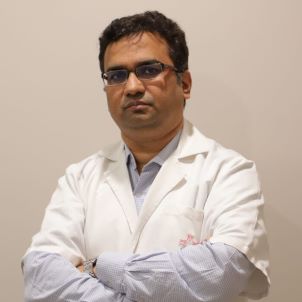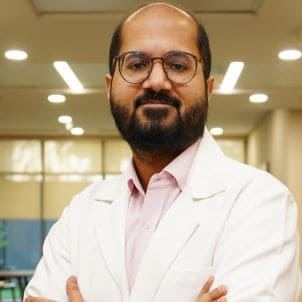- Home
- /
- Speciality
- /
- Otology
Otology (Otorhinolaryngology) is a principal subspecialty of the Department of ENT (Ear, Nose & Throat) Surgery at the CK Birla Hospital®. It deals with the assessment, diagnosis and treatment of the full range of ear-related disorders, infections and illnesses. Our ENT specialists offer round-the-clock care to help manage and improve your hearing sense as well as your quality of life. We provide both medicinal and surgical expertise for a large number of ear conditions ranging from relatively common ones to rare complexities. We offer precision-driven elective and emergency surgical interventions for ear abnormalities. Our team has a combined experience of over 3000 successful surgeries including advanced cochlear implants.
Otology conditions we treat
Ruptured eardrum
A ruptured eardrum or a perforated eardrum is defined as a hole in the eardrum. The perforation occurs in the thin tissue that separates the ear canal from the eardrum. This condition can occur as a result of ear infection, injury or changes in pressure. Common symptoms of ruptured eardrums include sudden hearing loss, pain, itching, leaking of fluid from the ear, high body temperature and a ringing or buzzing in the ear. Ruptured eardrums can be treated with medication, surgery or ear patches.Hearing loss
Hearing loss can happen when any part of the ear or hearing system does not function properly. There are mainly three types of hearing loss - conductive, sensorineural and mixed. A person can experience mild to profound degrees of hearing loss in one or both ears. Hearing loss can occur gradually as a result of ageing or due to long-term exposure to loud noises. Treatment protocols depend on the severity and type of hearing loss. Primary treatment modules include hearing aids, surgery and cochlear implant.Cholesteatoma
Cholesteatoma is a benign ear disease that causes the formation of abnormal growth behind the eardrum. This condition leads to the growth of a non-cancerous cyst containing skin cells and connective tissues. Cholesteatoma can be acquired or congenital and may continue to grow if not treated timely. Treatment is based on the extremity of the mass growth, the severity of symptoms, age and overall health of the patients.Tinnitus
Tinnitus is a condition in which you experience a ringing or buzzing noise in one or both ears. This sensation can be constant or may come and go periodically. You may experience a roaring, clicking or hissing sound. It is more of a symptom than a condition and indicates an underlying health condition such as hearing loss or ear injury. Tinnitus management is done by a comprehensive treatment of the underlying cause, noise suppression machines and medications.Dizziness
Dizziness is characterized as an impairment of spatial orientation. It is used to describe a range of sensations including a feeling of imbalance, weakness, nauseous, lightheadedness or unsteadiness. There are several causes that contribute to feeling dizzy such as cardiovascular problems. Dizziness treatment depends on the underlying cause and includes balance assessment and vestibular rehabilitation.Ear Infections
An ear infection is an infection that occurs in the middle ear. The middle ear is the air-filled area behind the eardrum containing tiny vibrating bones of the ear. Ear infections occur when the middle ear fills up with fluid. The symptoms of this condition vary from children to adults. Common symptoms include ear pain, fever, irritability, difficulty sleeping, and drainage of fluid from the ear. Ear infections can be effectively treated with watchful waiting and medications.Otosclerosis
Otosclerosis causes abnormal bone growth inside the middle ear that can lead to hearing loss. Other common symptoms of this condition include difficulty in hearing low sounds, vertigo, dizziness, ringing in the ear and speaking quietly because of louder noises. Otosclerosis treatment can be done with the support of hearing aids or surgical intervention called stapedectomy.Tumour
Abnormal growth on the inner, outer or middle part of the ear is described as an ear tumour. The tumour mass can either be cancerous or non-cancerous and affect your hearing. Ear tumours are different from ear cysts as these are solid masses while cysts are fluid-filled sacs. The treatment protocol depends on the type, size and location of the tumour.Tests & procedures performed
Audiogram
An audiogram is a hearing test that is done to measure hearing sensitivity. It is a non-invasive and painless procedure. The results are shown on a graph that reflects how a person listens to the softest sounds at different pitches and frequencies.Ear endoscopy
Endoscopic ear surgery is a non-invasive procedure done to diagnose and treat ear abnormalities. In this surgery, a long, thin tube attached with a light is inserted inside the patient’s ear canal. The endoscope allows the surgeon to visualise the insides and access ear diseases.Microscopic ear surgery
Microscopic ear surgery is a minimally invasive surgery that allows the surgeon to operate on the tiny and delicate structures in the ear. These surgeries aim to repair, reconstruct and treat different types of ear abnormalities.Our ENT specialists
Be a super-mom, stay informed about pregnancy health updates with our weekly newsletter
[contact-form-7 id=”16292″ title=”Subscribe”]
FAQs
What is the difference between Otology and Otolaryngology?
Otology specifically deals with ear problems while otolaryngology focuses on the comprehensive care of the ear, nose and throat.
What is the ear flap called?
The ear flap, outer ear area is known as the pinna.
Can you hear without ossicles?
Broken, missing or injured ossicles can reduce your hearing by a large amount of air conduction.







